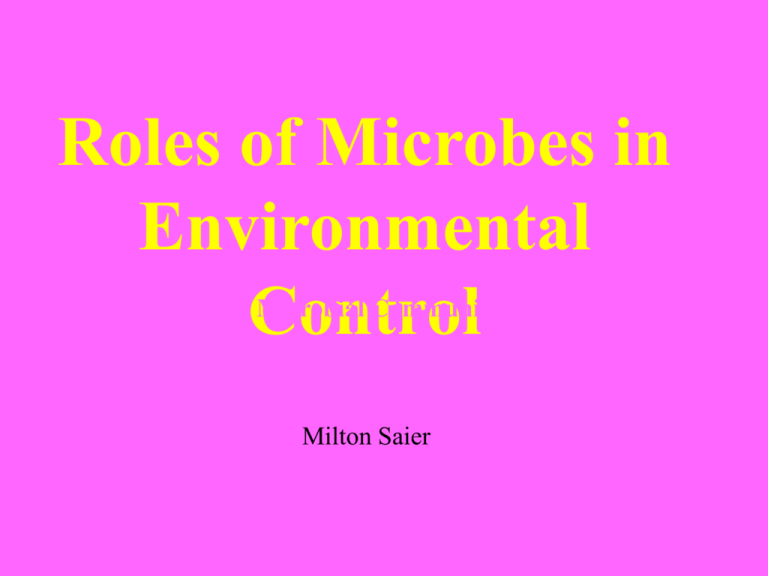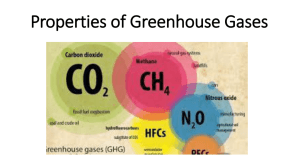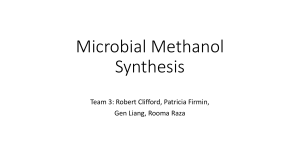Microbes and the Environment
advertisement

Roles of Microbes in Environmental Control Microbial Communities and Global Change Milton Saier The 3-Domain System Based on ribosomal RNA gene sequences Almost all life is microbial! The diversity of microorganisms is vast The “crown group” of Eukaryotes includes animals, plants, fungi and multicellular algae Microbial Communities Fantastically diverse: Thousands of bacterial species are present in a gram of soil. Most have never been isolated in a laboratory. They are not well understood. Control global (and local) biogeochemistry: Most steps in the C, N, S cycles are performed exclusively by prokaryotes (including trace gas production). Decomposition is dominated by microorganisms (bacteria and fungi). Photosynthesis: ~half of Earth’s primary production of carbon is by cyanobacteria and algae. Plants and algae use cyanobacterial photosynthesis because chloroplasts evolved from cyanobacteria. Species-specific interactions with plants, animals and fungi: Mutualisms (mycorrhizae, nitrogen fixers); Parasitisms (diseases). Possible Microbial feedbacks in global change Plant community change ? Plant growth _ Nutrient mineralization _ + + Warming + CO2 increase Microbial Respiration Red = positive feedback (destabilizing) Green = negative feedback (stabilizing) Purple = uncertain Microbial trace gas production Nitrous oxide (N2O) About 300 ppb in the atmosphere. Strong greenhouse gas: 200X worse than CO2. Lifetime = 150 years. Contributes to stratospheric ozone depletion (after conversion to NO, nitric oxide). Methane (CH4) About 1.7 ppm in atmosphere. Strong greenhouse gas. About 25 times worse than CO2. Important in ozone chemistry. Elevated atmospheric CO2 NOx in fossil fuel emissions Clean air act However, N2O concentrations now increase ~0.3%/year. Atmospheric methane is increasing in the industrial age… But why? (aerobic) (anaerobic) CO2 respiration C fixation* Organic C Methanogenesis (methane synthesis) Methanotrophy (methane oxidation) CH4 (methane) *- primary production, i.e. photosynthesis, chemoautotrophy, nonphotosynthetic CO2 fixation. Methanogens (Archaea) Methanopyrus sp. Methanococcus jannaschii Trichonympha, a symbiotic protist (a flagelated protozoan) in the termite gut. It possesses its own symbiotic methanogens (archaea) which break down cellulose and produce nutrients + methane. It also has spirochetes embedded in the outer leaflet of its membrane which confers coordinated motility to the host. It is not known if Trichonympha directs the motility of the spirochete, or if the spirochetes coordinate their motility themselves to move the Trichonympha (“teardrops with wigs”). More symbiotic termite gut protists are present in termites: the flagellated protozoans Dynenympha and Microjoenia. They contain their own symbiotic methanogens. Termite gut epithelium with symbiotic methanogens (E) Global N cycle (Units are 1012g/year) Simplified Nitrogen cycle anaerobic N2 Nitrogen fixation NH4+ (by-products of nitrification) N2O (N2O, NO) Organic N denitrification ammonium oxidation (nitrification) NO3- NO2nitrite oxidation (nitrification) aerobic Nitrosococcus nitrifiers Nitrosolobus Nitrospina Nitrosospira Nitrosomonas Methane production in rice paddies Rice paddies: Projected to increase by 70% in the next 25 years. Anaerobic: rich in organic C – leads to methane production. Some oxidation occurs due to the presence of O2 conducted by the rice plants into the rhizosphere. Effects of N fertilizers: They STIMULATE plant and methanogen growth. This STIMULATES methane production. They also INHIBIT methane oxidation (in most studies of upland rice and other ecosystems…). This also STIMULATES methane production. Agriculture and Nitrous oxide N2O NH3 NO3- “leaky pipe” model More N fertilization leads to more NOx emissions N2O Eutrophication Nitrogen and phosphorous nutrients lead to blooms; the oxygen is used up; algae decompose, and fish suffocate. Effects of fertilizer runoff on denitrification in coastal areas Off the coast of India during monsoon season: N in runoff causes eutrophication of coastal waters. Lower oxygen leads to fish kills and increased biological pollution. Lower oxygen also leads to increased rates of denitrification. This may eventually lead to nitrogen deficiency. Insufficient N may result in stunted aquatic plant growth. Unavailability of nutrients can then prevent fish reproduction. (Naqvi et al. 2000) Hypothesized denitrification effects on global climate after the last glacial maximum (~22,000 ya) High denitrification rates in ocean Lower NO3- in marine environments Lower plant production rates in the oceans Slower CO2 removal by ocean Climate warms Beneficial Bacterial Bioprocessing 1, Photosynthesis 2, N2 Fixation 3, Symbioses 4, Gut nutrition 5, Probiotics; prebiotics 6, C, N, S, P cycles 7, Mineralization/demineralization 8, Denitrification 9, Waste decomposition 10, Methane oxidation 11, Food production 12, Biofuel production 13, Diverse, interesting and entertaining 14, Human population control? Quiz 1, Please name and describe four distinct processes that bacteria catalyze that affect our biosphere in a beneficial way. 2, Termites have endosymbionts with endosymbionts within them. Please explain in general terms what these three (or four) types of organisms are, what they do for the termite, and how they affect the biosphere. 3, Please show or describe how denitrification is believed to affect global warming. 4, Please describe what “living in a McDonald’s society” means, and what the consequences to people and the environment are.






